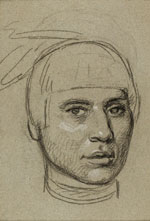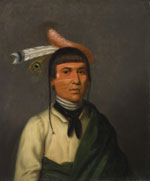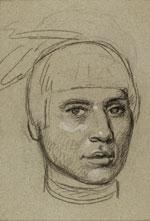In my previous post, I wrote about my process of deciding where to place Henry Inman's portrait of Chippewa chief No-Tin, which is now on view in our gallery displaying American decorative arts and portraiture from the early 1700s to the early 1800s.

Charles Bird King, Study for a Portrait of Chippewa Chief No-Tin, c. 1830, American Art Council Fund
I decided that situating this historic individual in the midst of relative contemporaries was paramount for his debut in our galleries, even though space proved a little tight in our front gallery. What made the options for placement somewhat limited was the exciting opportunity to install at the same time an original drawing of No-Tin—made from life for his portrait by a different artist, Charles Bird King. Rather than show the two works exactly side by side, I placed them adjacent to each other on two different walls, so each can be seen independently.
The links between King's small drawing and Inman's stately oil are fascinating, and their histories are interconnected but distinct. In my previous post I had mentioned that No-Tin was a Chippewa chief who came with his tribe's delegation to Washington in the mid-1820s. Thomas L. McKenney, then head of the U.S. Bureau of Indian Affairs, commissioned King to make portraits of the Indian chiefs for a national Indian gallery. No-Tin sat for King, who drew the vivid chalk-and-charcoal portrait in preparation for his own painting of No-Tin.

Henry Inman, No-Tin (Wind), 1832-1833, Gift of the 2008 Collectors Committee
King's portrait and those of over 130 other Indian chiefs were all on permanent display to the public in the War Department offices in Washington, D.C. Later they were transferred to the Smithsonian Institution, where they were all destroyed by fire in 1865. But it was the passage of the Indian Removal Act in 1830 that encouraged McKenney to make the portraits in the Indian Gallery as widely available to the public as possible. He planned another commission and knew that only a successful artist, one more accomplished and ambitious than King, could produce the kind of compelling paintings that would become well known outside Washington. That artist was Henry Inman.



